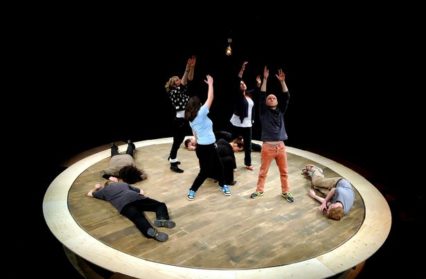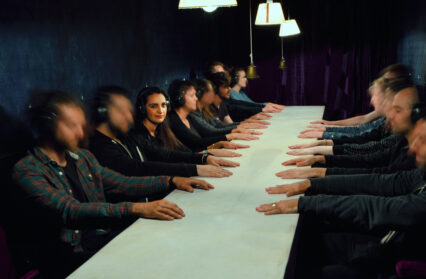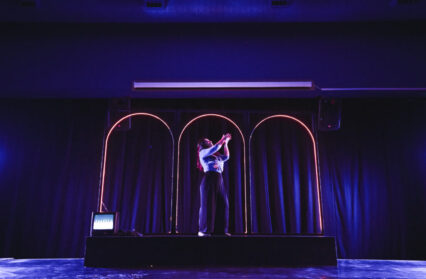Julia Bainbridge casts a critical eye over Sherman Cymru‘s Company 5’s latest production, D.J. Britton’s To Live, To Love, To Be.
After last year’s glut of Shakespeare performances as part of the 2012 London Olympics, I was curious to see whether D.J. Britton’s play at Sherman Cymru offered a new angle on the world’s most famous, yet most anonymous playwright. It certainly seemed promising as I entered the smoky netherworld of Theatre 2 and found myself looking down onto a six-metre wide séance table. Not so promising if you couldn’t manage the stairs in your wheelchair (Sherman Cymru take note), but director Phillip Mackenzie’s recreation of a Victorian séance beguiled immediately. This was a world of shadows and spirits and the smoke and cloying incense, redolent of death, were perfect in setting up what was to follow.
The giant séance table became a revolving stage upon which the spirit of William Shakespeare was to be summoned. Clever lighting and screening created an illusion of people and ghosts passing through different time frames, enhanced by ethereal music composed by John Rae. By remixing and stripping music composed for or influenced by Shakespeare’s work, Rae had created an original soundscape which gave a spiritual, unworldly feel to the performance. It worked well.
As to the performance, Britton used the form of a séance as a platform to explore the people and factors which may have influenced or inspired Shakespeare’s writing. This makes for an interesting concept, but the influences introduced here were linked together to form an unconventional narrative. It wasn’t long before I was confused as to who was who and what was going on. The performance switched between characters from Shakespeare’s childhood to rather long extracts from some of his plays, intersected with choreographed writhing from Shakespeare’s spirit summoned from the afterlife. Fortunately Shakespeare’s spirit seemed to vanish for most of the latter part of the production. I had to resist looking at my watch during the long and weighty chunks from Macbeth and The Tempest, but thankfully these were balanced by the delightful adaptation of The Shepherds’ Play from the Wakefield Mystery Cycle. Thought to have been written in the mid fifteenth century, this play would most certainly have been familiar to Shakespeare as it was performed by travelling players at religious festivals around the country, annually. This was by far the best part of the evening.
Company 5 is the Sherman’s own community performance group. It has an open door policy, no auditions are held and members range in age from twenty to sixty years old. Under Mackenzie’s direction, they gave a strong performance. There was nothing amateurish about the acting from any of the sixteen members of the cast. Paul Jenkins as the Mayor gave a particularly good performance, made more striking by his white dinner suit and hat. The delivery of the rhyming couplets as Mak in The Shepherds’ Play by George Goding was engaging and a treat to watch.
Overall, this is a good company of fine actors who handled the material well. It was the content that really let the performance down. What was it all about? Why was the Welsh influence overplayed? Who were all the characters and what were their roles? I came away with too many questions and not enough answers. But maybe that was Britton’s intention. When all the shouting and conjecture is over, we still don’t know much about Shakespeare or about what influenced his writing. As King Lear said, ‘Nothing can come of nothing’.











